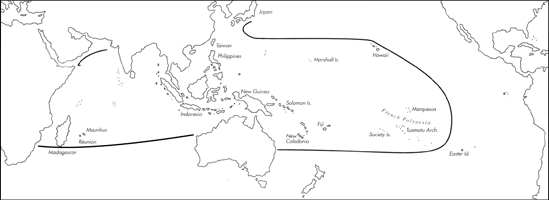
Skip Navigation Links
View access keys for this site.

Range: Entire Indo-Pacific.
Description: Large and heavy; relative weight may vary by 40 %. Last whorl usually conical; outline almost straight, sometimes convex at adapical fourth. Base truncate. Shoulder angulate, occasionally subangulate. Spire of low to sometimes moderate height, outline slightly concave to slightly convex. Middle and late teleoconch sutural ramps concave, with 3 increasing to 4 - 6 spiral grooves; grooves usually faint on last ramps of large specimens. Last whorl with weak spiral ribs above base, obsolete in old specimens.
| Shell Morphometry | ||
|---|---|---|
| L | 80-222 mm | |
| RW | 1.40-5.00 g/mmm | |
| (L 80-170 mm) | ||
| RD | 0.58-0.71 | |
| PMD | 0.81-0.93 | |
| RSH | 0.00-0.15 | |
Ground colour white. Last whorl with spiral rows of dark bluish brown spots or short axial streaks. Teleoconch sutural ramps variably maculated with dark bluish brown oblique axial blotches. Aperture white.
In subadults, periostracum yellowish olive, thin, translucent, and largely smooth, with short fringes at shoulder edge. In adults, periostracum reddish brown to dark greyish brown, thick, progressively opaque, and velvety or rough.
Foot thick and fleshy; dorsum tannish white to tawny or mottled dirty brown and white; anterior part with a diffuse black pattern at centre and white corners; lateral and posterior marginal zone with diffuse black streaks radiating from a dotted black pre- marginal line. Sole of foot dull white mottled with brown or greyish brown, with darker brown interlaced longitudinal veins and sometimes with purplish brown to black blotches. Extent of different colour zones variable depending on contraction or expansion of foot. Rostrum white variably washed with cream to tan, sometimes orange. Tentacles white or white washed with beige. Siphon dull white, creamy yellow or buff grading to yellowish buff anteriorly, with a black halfring at centre; often with sparse additional tan blotches on dorsum, occasionally with an additional black latero-ventral blotch somewhat posterior to the black half-ring (Garrett, 1878; Kohn 1959 a & unpubl. observ.; Chaberman, pers. comm., 1981; Pearson, unpubl. observ.).
Radula and venom apparatus poorly developed. Radular teeth small, with an adapical barb opposed to a second weak but large barb; long serration terminates in a cusp; base with a spur (Bergh, 1895; Peile, 1939; Kohn 1959 b & 1981).
Habitat and Habits: Slightly subtidal to about 45 m usually below 2 m. Mainly in shallow bays with vast subtidal stretches of sand or sand with vegetation; also occupying large areas of sand or sand and rubble on subtidal reef flats; less common where subtidal reef flats pass into smooth intertidal limestone benches (Kohn, 1959 a, b, 1968, 1980; Kohn & Nybakken, 1975; Cernohorsky, 1964, 1978; Tirard, pers. comm., 1989). C. leopardus feeds exclusively on enteropneusts (Ptychodera flava) by engulfing its prey without stinging it first (Kohn, 1959 b, 1981; Endean & Rudkin, 1965). Observed to oviposit in 0.2 - 1.5 m of water on sand or sand and rubble. Egg capsules deposited in irregular rows, affixed to the underside of granite rocks, coral rocks and coral heads by confluent basal plates. Observed to spawn together with C. textile and C. virgo at the same place without interspecific competition. Capsules measure 26 - 58 x 19 - 37 mm and contain 2,900 - 12,800 eggs; observed number of eggs per capsule mass is more than 744,000. Egg diameter varies between 204 - 240 fm depending on locality, predicting a minimum pelagic period between 23 and 21 days (Kohn, 1961 a, b; Perron, 1980; Perron & Kohn, 1985; Cernohorsky, 1964).
Discussion: C. leopardus is closely allied to and sometimes mistaken for C. litteratus. For comparison, see DISCUSSION of the latter species.

C. leopardus Range Map
This section contains verbatim reproductions of the accounts of 316 species of Conus from the Indo-Pacific region, from Manual of the Living Conidae, by Röckel, Korn and Kohn (1995). They are reproduced with the kind permission of the present publisher, Conchbooks.
All plates and figures referred to in the text are also in Röckel, Korn & Kohn, 1995. Manual of the Living Conidae Vol. 1: Indo-Pacific Region.
The range maps have been modified so that each species account has it own map, rather than one map that showed the ranges of several species in the original work. This was necessary because each species account is on a separate page on the website and not confined to the order of accounts in the book.
Return to framed version (returns to search page)